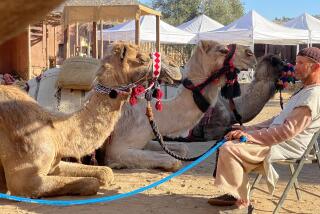2 Tons of Trouble for a Rare Turkish Delight: Wrestling Matches Between Camels
- Share via
SELCUK, Turkey — When Coral and Black Lightning entered the ring once used by Roman gladiators, the camel wrestling fans went wild: There was no doubt that each contestant was two tons of trouble.
The spectators have a big thirst for the bizarre sport pitting the desert beasts of burden against each other in a series of tournaments that run from November--the start of the camels’ mating season--to mid-March.
But the competition still faces its biggest hump: a lack of contestants.
This match at the sixth annual Selcuk Camel Wrestling Festival--the biggest of the tournaments--drew 25,000 Turks and foreigners to the stadium of the ancient Ephesus, a major Greco-Roman city of Asia Minor that is now an open-air museum.
Camels Decorated
Owners and assistants led the 39 pairs of camels, decorated with color packs and bells, into the ring to the accompaniment of drums and double-reeds played by local musicians.
The camels, whose jaws are bound to prevent biting, are goaded into battle until referees--one in the field and five on the sidelines--decide that there has been enough. Each camel has nine assistants who separate the animals when they get locked in combat.
The beast that brings its rival down so its hump touches the ground is declared the winner. Victory also is declared if one camel forces the other to give up and run away.
A match ends in a draw if they reach a stalemate or one is injured.
Sometimes the camels get so excited they run over the wire fences, to the alarm of the spectators, who keep up their spirits with barbecues and plenty of alcohol.
Hotly Contested
Disputes often break out even after a winner is declared.
“Being a referee is most difficult. If a camel wins, they say it because it was stronger; when they lose or draw, they blame it on us,” said Husamettin Basoglu, the field referee.
Basoglu, 34, an engineer who also has raised four champion camels, said the matches aren’t allowed to go on for more than 15 minutes because of the risk to the animals.
“We used to have matches lasting up to 45 minutes . . . but we cannot do it now as the number of wrestling camels is decreasing continuously,” Basoglu said.
All the wrestling camels are male, offspring of Bactrian fathers with two humps and dromedary mothers with one hump. They start wrestling at age 7 and are retired about age 25.
Shortage of Bactrians
“There have been no Bactrians in Turkey for the past 15 years. If the government does not import a few soon, this sport will be a thing of the past in less than a decade,” lamented Ali Ozer, 68, who owns four camels.
Ozer, a poultry farmer, said he raises camels for fun like most other camel men, but there are a few others who can earn an average of about $2,900 if they participate in about 20 tournaments a year.
Ritual surrounds the matches. The title of aga , a kind of honorary president for the year, was auctioned to farmer Hasan Kayali for about $1,150. He received a special jacket, a shawl, a silver-plated belt and a pocket watch, as well as the right to strut about the ring.
But a key part of the two-day festival here is the drinking and camaraderie that go with the virtually all-male pastime.
Camel men drank until nearly dawn one weekend in a bar in Selcuk, the town close to the ruins of Ephesus. The beverage of choice is raki , the traditional Turkish anise seed spirit. As the men imbibed, two belly dancers proceeded from one table to the other for hours.
As for the battle between Coral, 14, and Black Lightning, 17, the 2,200-pound contestants in the heavyweight bout of the Selcuk tournament, the judges called it a draw after five minutes.
More to Read
Sign up for Essential California
The most important California stories and recommendations in your inbox every morning.
You may occasionally receive promotional content from the Los Angeles Times.












